
The discussion on the development direction and path is very important for every industry. In 2020, almost all public libraries have spent a special year in the fight against the COVID-19. Today, the impact of the epidemic continues and on the road of exploring the "Future", there are more challenges for the public libraries. Face to various uncertainties, what are librarians in the world thinking and doing? As the society is constantly upgrading and iterating, can public libraries catch up with the epoch development? What role should the public library play in the good life that people yearn for? With these questions in mind, we interviewed some iconic figures in the field of libraries in various countries to talk about their 2020 and views on the future of public libraries. We hope that our interviews will enable librarians from different countries to better understand each other and have a firmer belief that the future of public libraries will eventually be a bright and splendid world.
In this issue, we will launch an interview with Marie Østergaard, Library Director Aarhus Public Libraries and Dokk1.
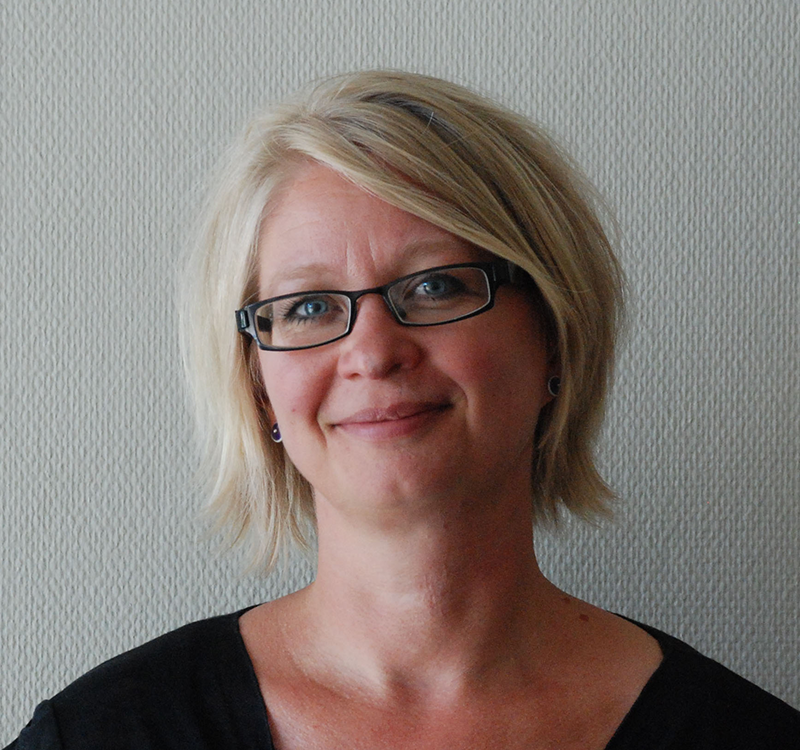
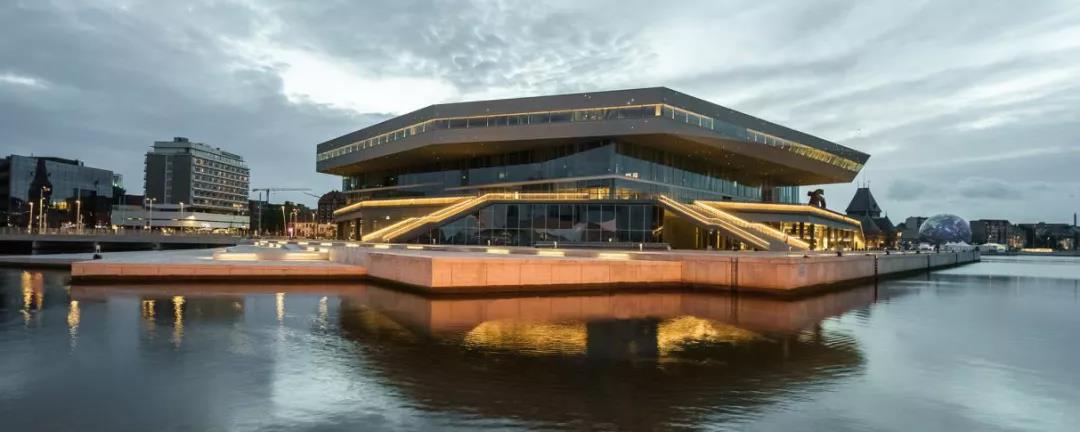
As we closed down our libraries due to the restrictions in connection to the spread of COVID-19 this was the first time in probably more than 50 years that public libraries had been shut down in Aarhus. Thus, there was no script or recipe to follow. And as for many around the world it seemed so unlikely a thing to happen. Everybody was sent home working – luckily Denmark has a very high internet penetration, so people were able to work and connect from home.
Very quickly we realized that we needed to experiment with new ways of doing services and programming online for the citizens – something that neither citizens nor staff had any particular experience with.
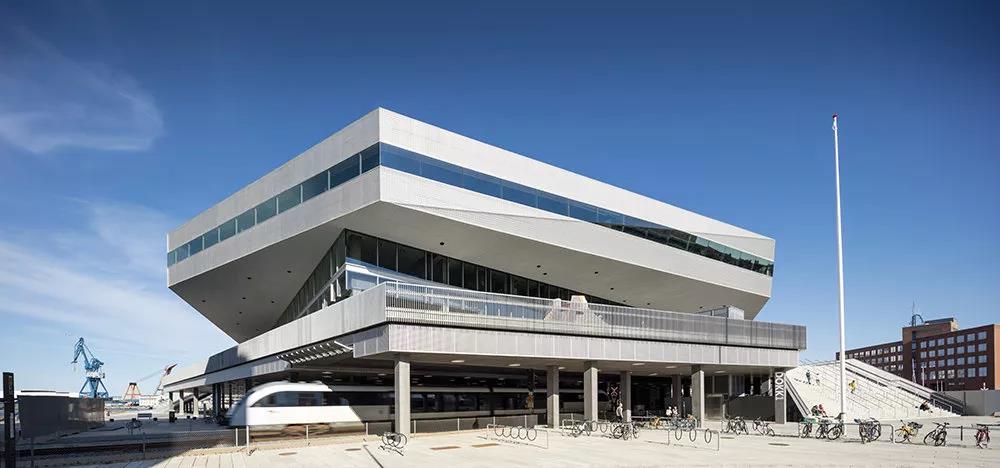
In Aarhus we have worked for many years with design thinking when developing new services, and we put this to use in this case too – prototyping and experimenting, talking online to citizens and developing new types of services and formats that could be accessed online. We focused highly on what we called “the relational library” – to see how we might create programs that would connect people and create communities even when it was online, with citizens that were unaccustomed with meeting or learning online before.
Throughout the year we have developed numerous new types of programming for various target groups: lonely elderly, young adults, maker-activities online for kids etc. as well as transformed existing physical formats into digital ones e.g., writer workshops, knitting groups, reading groups etc.). Many of these programs will continue after the libraries have again re-opened, as we have seen that the digital format can reach different target groups and connect different people than programs in the physical library. Other formats will be transformed back to physical ones, as we see it working better in that arena. And we will continue to develop on both types, as well as combined formats with both a physical and a digital component (I heard a colleague name it “phygital” formats). We are right now planning a big literature festival in June – LiteratureXchange – that will draw upon both in the program to include foreign authors digitally in conversations and workshops that take place physically in Aarhus.
In terms of lending of e-books the past year has seen a massive leap in borrowings. In Denmark we have a national digital library – the Danish Digital Public Library Association- that the libraries run together. This means that no matter where you live you have access to e-books and digital material. Borrowing of e-books has exploded during the times the libraries have been closed down, which is of course not surprising, but what is perhaps more interesting is that they numbers have stayed high even after libraries have re-opened. Basically, now we are looking at numbers telling us that more and more people have begun borrowing digital material as well as continued to borrow physical material. In many ways COVID-19 became the digital push that made people embrace e-books on a much broader scale than before – something that libraries have tried to do for many years. As a consequence, we have to re-think our budget for materials to make sure that the selection of e-books satisfies the need.
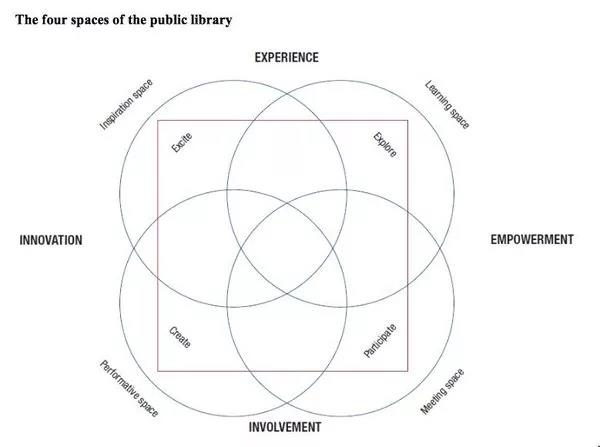
We believe that the four-space model is a relevant as ever. It can be a guide for both the physical spaces as well as services, and it is an important reflection tools on how we organize our services for the citizens as well as how we organize ourselves around it and what competences our organization must have. It reflects on both branding, competences, spaces and programming. Most importantly it highlights the continuous importance of insisting on the library being an active space where the citizens are in the center of everything – people are the key component of libraries, and we must ensure that we create opportunities and framework to support that.
One of the most important aspects of the space design in Dokk1 is the open integration of spaces and its human scale. We wanted to create a library that reflects that the library is the only place in our society where you meet across gender, age, political or religious belief, social background or financial means, in a non-commercial space. Perhaps it can be seen a little like the old village square, just with a roof on it. We believe that the library is a democratic space that with its space design as well as the services should promote societal equity, embrace diversity and stimulate cohesion. To do so a high level of space plurality is needed – different spaces that meets different types of needs – where you can come alone or come together – or even be together with someone you don’t know. And it must offer spaces where we meet people with opinions and thoughts that might not resemble our own, in an environment that feels safe enough for us to dare to investigate it.
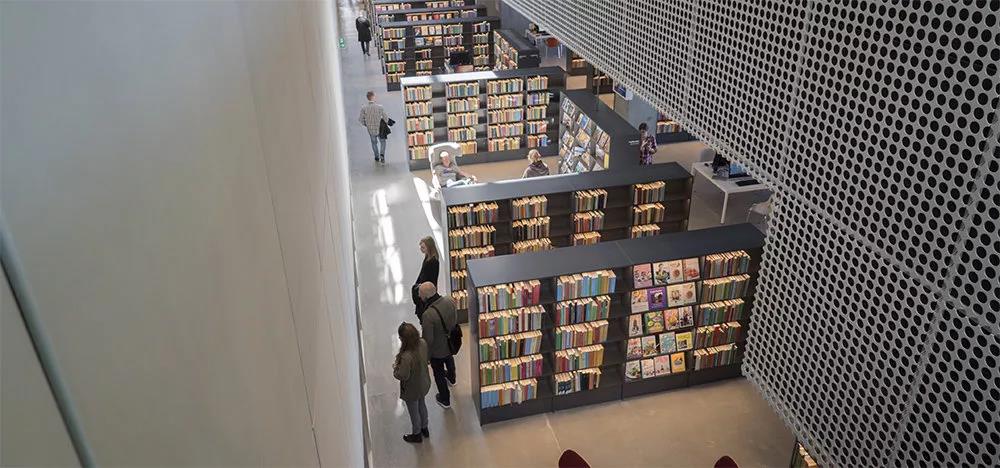
The human scale in space design is much more difficult to describe. But I believe we all feel it when we meet it – or when we meet the opposite. The space design must make you feel that you have space to breath and move freely, and although a building is large it must not make you feel small. It should not fill you with respectful awe – it should make you at ease and fill you with the urge to engage and inhabit.
When designing public libraries our first and foremost job is to make sure that the citizens know that the library is their space. It is not owned by the library. Therefore, space design must make them feel that they can own, inhabit, touch and use everything without being afraid that they break rules or have to ask permission. The space design must communicate the intentions of the spaces as well as make them easily adjustable for people’s own usage.
The open space design of Dokk1 as well as the many different types of spaces and environments in the building and the absence of rules make people feel comfortable and safe, as well as curious towards each other and what goes on in the building. That way they become more inclined to share, participate and engage and by that become part of the community feeling in Dokk1.
In Dokk1 people always come first and all usage of technology is about better access, personalized experiences and the ability to express oneself and navigate in a technological world. I believe it might be possible to roughly categorize technology in Dokk1 in three categories: efficiency, expression, and exploration.
When it comes to efficiency, we are using multiple technologies to improve access and self-service. Through Intelligent material systems, embedded wayfinding, app-based library systems and automatized self-service solutions all transactions in the library are digitalized and automated. It is a constant focus to keep making these solutions better and to use data to improve the experience for the users, without breaking the rules of personal data protection.
In the Danish Digital Public Library Association, we are continuously developing our e-book lending platform further. Next step is to develop a new platform for children that will create a universe where children can access both e-books and physical books through the app directly down to a local library level. The seamless connection between the digital and the physical library will be highly prioritized in the future.
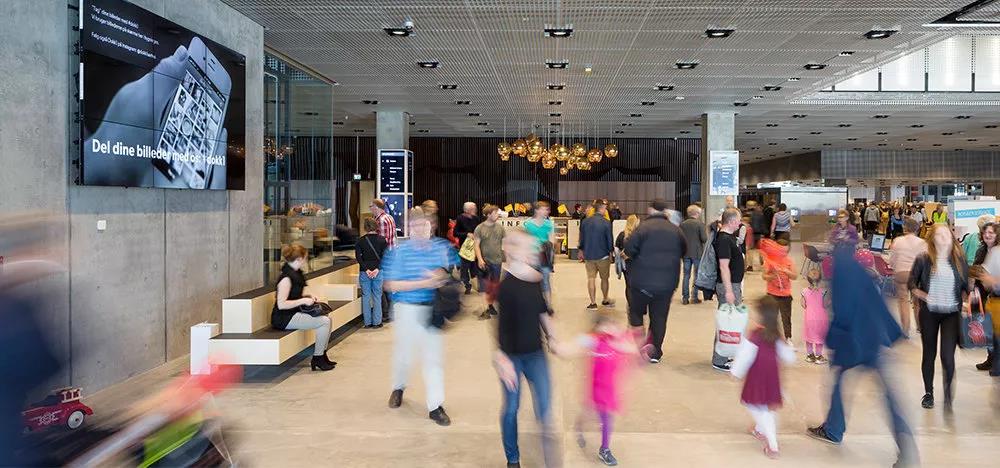
Digital development in terms of expression is a strong development area now and will be in the years to come. We need to improve people’s possibilities of expressing themselves online and in the physical spaces through different kinds of technology. We are developing new methods of online citizenship where user involvement and engagement can be done both digitally and physically within the same platform. And we focus on how things experienced in the physical library can have a before- and afterlife online in a seamless way. In Dokk1 citizens can access the screens around the building. If you #Dokk1 on Instagram, your post or picture pops up on the screens. It is a way of letting people share their experiences. But we want to take this further so that digital involvement may also be possible to influence for instance societal decisions or be a way of reaching out towards each other and create smaller communities of interest.
Using digital development to support and encourage exploration is an area that we are spending a lot of energy on as well. This will and must continue to have an experimental aspect, where we dare try new ways of applying known technologies or dive into new types of technology that we do not yet know the relevance of in a library context. We see how this can be a tool to connect people, to connect people and knowledge as well as stimulate curiosity and change behavior. For instance, when children play at our interactive learning floor, they suddenly need to be more attentive to each other and are able to work together without using verbal language, or when using augmented reality, we can stimulate people’s focus on specific climate issues that they want to address in their own lives. The curiousness, experimentation and urge to explore help both adults and children to play their way into new discoveries and experiences. As well as learning about technology. I strongly believe that we as libraries must make sure to always experiment with these kinds of technology and digital development, to investigate how they can be used and embedded in a library context, even if they were developed for something else originally.
I believe that to strengthen people’s media literacy is one of the library’s most important tasks at the moment. The massive usage of different media and data as well as the role they play in both our social as well as our professional lives demands that we in our current society must both understand and master the way algorithms, misinformation, data and surveillance influence our choices and our beliefs. It is not only a question of teaching people what it means – we need to make sure that everyone is capable of making their own informed choices. This is exactly what the library has always been about in terms of free and equal access to information and learning and it must be the same approach we have towards media literacy. In Dokk1 we have been working for three years with this theme, training both staff and citizens and making it an integrated part of our learning programs and our debates. In our development project “Data-Democracy” we have experimented with ways to make data- and media literacy an integrated part of library services and programming for both children and adults. We are integrating it in our maker-activities, and we are currently building IRIS - a new media learning lab in Dokk1 for children, where they can learn to master many different types of media productions as well as understanding the systems behind it. It creates better learning as well as teach them production skills as part of a massive STEAM initiative (Science, Technology, Engineering, Art, Mathematics).
The role of the library may differ from country to country depending on the educational system. But in Denmark it is important that the libraries focus on the informal learning and help connect people in communities of interests so that they may learn and get inspired from each other as well.
For us, it is important to insist that libraries are not part of the formal educational system but is about life-long learning based on the desire to learn and evolve. It is about giving every citizen the opportunity to grow and stay competent in their own life in the areas they desire. Some people will come to the library to learn more about something specific, but most people need the library to feed their curiosity for more knowledge perhaps on a broader level and in a more playful manner. A national example is that in Denmark all library directors came together to create a strategic agreement on focusing on children’s urge to read. Children learn the skills to read in school but all research show that this doesn’t necessarily make them good readers or make them want to read. This is where the library steps in. We must focus on how to stimulate children’s own desire to read – a desire that has nothing to do with formal skills or curriculum but instead focuses on awakening the child’s curiosity and pleasure of reading. Something they want to do because it is fun, not because they have to or to become better. And that demands something completely different than placing the child at a table with a book.
Children and adults are not that different – and in all skill sets and arenas the libraries must work with how to stimulate the curiosity and desire to learn more or to investigate further. As libraries we need to be inspirational.
We have a strong partnership with both other parts of the municipality that works with vulnerable groups as well as partners around the city and country that have this focus. Libraries are for everyone and we know that there are different barriers in using libraries that we need to break down. One of the difficulties is that in order to address a specific vulnerable group directly you risk stigmatizing the people within it. Therefore, we make sure to partner up with good networks that can direct us towards the groups we want to address and make sure that our focus is always on the content. We work dedicatedly with services dealing with loneliness – both among young adults and elderly, with people with dyslexia, with psychologically vulnerable young people and of course make sure that our libraries are accessible both physically and psychologically.
Both in terms of vulnerable groups and when focusing on diversity we ensure that our programming and events reflects the diversity in society, because representation carries enormous weight. We believe that the library must be a place where you can go and learn about for instance mental illnesses, structural racism or gender issues, and perhaps find others struggling with some of the same issues as yourself. But just as importantly a place where you can come and be yourself no matter who you are in a safe and inclusive environment and where you meet or see others that resemble you.
Denmark is one of the most creative countries in the world, and DOKK1 is also a public library reputed for its innovation. You have created a very flexible and open conference form known as "next library", encouraging librarians’ interaction and knowledge sharing, constantly changing and breaking boundaries to support learning in the next century. What is the most important quality of future librarians in your view? How should we training future-oriented and smarter librarians, and build the future leadership for public libraries?

Through the years it has become increasingly clear that the skills needed to work in public libraries like Dokk1 is more directed at competences than anchored in a specific professional education.
But also, that diversity in staff is essential in order to be who we need to be. Qualities like curiousness, openness, willingness to try and fail as well as a general humanistic approach towards the world are essentials in order to navigate in libraries today.
In Aarhus we have worked heavily with design thinking in development of services, buildings, and new ideas. To be a great design thinker you need to be able to listen, watch, reflect and analyze. And you need to dare try something without knowing whether it will work. These are perhaps some of the most important skills you can have both working with people and working with innovation. It also means that staff needs to dare – to have courage and curiosity to make decisions and do things on their own. This demands leadership that are willing to encourage it. It demands an un-hierarchical form of thinking in an organization and an explicit organizational culture where your leader will support you if you experiment, try and fail.This is not as easy as it sounds. But nevertheless, it is becoming more and more clear that without this there will be no innovation, only stagnation because of the fear of failing.
Our staff is the most important investment that we have in libraries and as leaders we need to be able to continue to give them possibilities to grow their potential, test their abilities and get inspiration from the surrounding world. And we should always embrace having staff that are smarter, more experienced or faster than us and have the courage to challenge their own boundaries. Leadership too is about listening, reflecting and analyzing.
The art in Dokk1 was part of the building project. In Denmark it is decided that in public building projects 1% of the construction money must be used on public art. During the building process we made three different international competitions for art. together with the architects we pointed out the important places in Dokk1 where art could engage with both library vision and architecture and form an even greater user experience. Like the building and the ambition for the library we wanted the art in Dokk1 to have an extraordinary quality that would attract interest in itself. We would rather have three important pieces than 100 insignificant ones.
All the art pieces are placed in “cross-roads” and they force you to stop and think about your pre- conceived beliefs or about how you perceive the surroundings. Just like a library does.
I don’t’ believe that we can ever do enough when it comes to sustainability. But we can keep trying. The building itself has been developed with strong standards for both environmental and social sustainability: https://dokk1.dk/sites/default/files/uploaded_files/dokk1_baeredygtighed_a5_6s_web_0.pdf . But the building and space design is of course not enough to continue to be a sustainable icon.
Our four-year strategy for Libraries in Aarhus is based on the UN’s Sustainable Development Goals (SDG). All themes and initiatives are attached to specific goals. The four-year strategy has been passed by the city council and has paved the way for how SDGs must be incorporated into strategies in other arenas in the municipality.
In 2020 we decided to specify the SDGs as a two-year strategic initiative for development. This means a deep dive into how our libraries should work with the SDGs, prototyping, design thinking, user involvement, networks and partnerships. We have appointed a large working group across the 19 libraries to work on this, to ensure that we focus on the SDGs in a broad perspective and not only on climate sustainability. Climate and sustainability will of course be an essential part, but also social sustainability, education, equality, health, information access, innovation and much more will be central to the development of new services and new roles of the library.
We focus on three aspect: a. What can we do in our own institution to strengthen the SDGs? b. How can the libraries strengthen knowledge in our communities about the SDGs? And c. How can we be a hub for and help others who want to strengthen the SDGs through a diversity of initiatives?
We have dedicated a number of physical spaces for this – the two most significant being Grow Your Library and SDGLab.
Grow Your Library – revolves around a commune garden in Risskov Branch Library with a specialized focus on sustainability. The community borrows pieces of the garden and grow their own vegetables, and the library facilitates a community around it, with events around sowing, harvest etc. The library then, in addition, develops programs around sustainability and support local initiatives.
SDGlab is a large appointed a physical space in Dokk1 to work with SDG number 17 – build partnerships. Here we experiment with network and partners across knowledge arenas and sectors on how to strengthen the SDGs on a local, national, and global level. It also functions as a test space for the library’s two-year strategic initiative and is both a workshop space, a tool library and a hub for meeting others working with the SDGs.
Finally, we work strategically with this in our library programming and our communication. As part of our focus, we have highlighted and strengthened activities that evolves around the SDGs for general citizens as well as for schools and kindergartens. We highlight in our communication which activities are developed within this framework – often with or by partners.